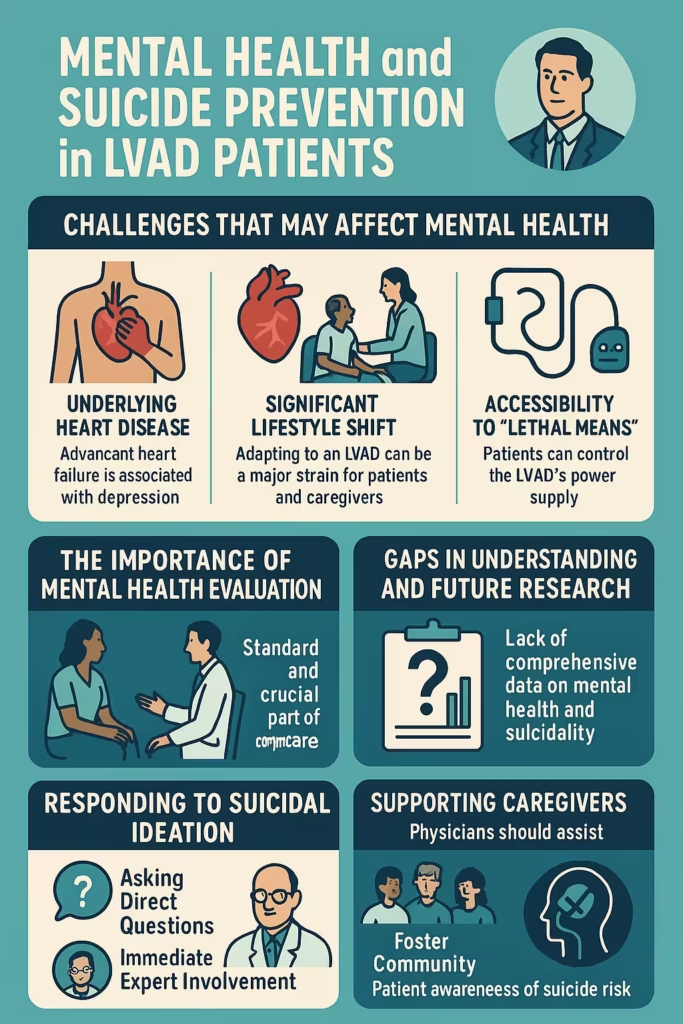Key takeaways:
- The apparent suicide of a patient with an LVAD sparked discussion about mental health in this population.
- Healio spoke with Quentin R. Youmans, MD, MSc, about mental health screening and suicide prevention.
When a 70-year-old man with advanced heart failure and a left ventricular assist device seemed to intentionally disconnect the device, the act led to a series of spiraling events, and ultimately death shortly thereafter.
Mr. M, the patient, had the LVAD for 4 years prior, but many other factors were in play, including chronic kidney disease, worsening right ventricular failure, acute kidney injury, cirrhosis and emotional distress.

Mental health evaluation is an important step in the care of any patient, but individuals with an LVAD are in a unique position of lethal means accessibility, by disconnecting power to their device or the driveline, Quentin R. Youmans, MD, MSc, heart failure and heart transplantation at Northwestern Medicine Bluhm Cardiovascular Institute, and colleagues wrote in their perspective published in the Journal of Cardiac Failure.
In their document, Youmans and colleagues discuss Mr. M’s case, risk factors for suicide, screening and prevention of suicide in this population as well as the ethical considerations surrounding discontinuation of end-of-life sustaining medical care.
Youmans and Alyssa M. Vela, PhD, vice chair for equity in the department of surgery and assistant professor of surgery (cardiac surgery) at Northwestern University Feinberg School of Medicine, also previously discussed these topics on Northwestern Medicine’s Better Edge podcast.
Healio spoke with Youmans about the contributors to mental health decline associated with LVAD use, the importance of both patient and caregiver mental health and the next steps if a patient expresses suicidal ideation.
Healio: What aspects of LVAD use do you believe take the biggest toll on patients’ mental health?
Youmans: One of the things we know is there’s an association with HF and depression and heart disease in general. When patients are being discussed or recommended for LVAD, there’s a recognition that they have an underlying advanced-stage heart disease, and that alone can contribute to depressive symptoms.
The next piece is that needing an LVAD is a big shift in lifestyle. There’s a big adaptation that patients must undergo. When we are evaluating patients for advanced therapy, whether it’s transplant or LVAD, we have to think about the following: Is the heart sick enough? Is the rest of the body healthy enough? Do they have enough social support?
It can be a strain in terms of needing additional support, both for the patient and for potential caregivers. It is a harrowing time in general, recognizing that unfortunately, the heart has failed to a point where it needs something like an advanced therapy. All of those things can contribute to difficulty with adjusting, and a lot of times depression goes hand-in-hand. So there are a number of different factors that can contribute to potential for suicidality.
Healio: Are mental health evaluations a standard part of HF care in most systems?
Youmans: Absolutely. It’s an important aspect of comprehensive care, particularly for our patients with advanced HF. When we’re screening patients or discussing patients for evaluation for advanced therapies, we always are considering their current mental health and history of mental health. Thankfully, we have a fantastic and robust cognitive behavioral medicine team that evaluates many of our patients, particularly those patients in need and helps us as a multidisciplinary team to determine appropriate treatment steps, appropriate follow-up and ensuring we’re supporting patients even after the potential LVAD goes in.
One of the points we wanted to make with the article, and even on the podcast, was how important it is for teams, in terms of offering advanced therapies, to really have a targeted multidisciplinary approach to help patients.
Healio: What proportion of patients who developed suicidal ideation who have an LVAD also had a history of prior mental health issues or undiagnosed psychiatric disorders?
Youmans: It is difficult to say, because there still needs to be so much more data in this space. A lot of what’s written in the literature is case reports. There are some smaller series but, just like anything in medicine, we need to base our estimation in good science. This is a ripe opportunity to answer even more questions.
I would surmise we are probably underestimating the prevalence of mental health disease and potentially even the prevalence of suicidality in our patients. It’s very complex and there are so many things in addition to their heart disease that need to be covered. But it’s something that needs additional future research.
Healio: In a hypothetical situation, you have a patient with an LVAD who’s believed to have suicidal ideation or may even have spoken to you openly about their thoughts. What are the next steps and who do you get involved?
Youmans: The first step is to ask the question. Ask about mental health and ask how patients are doing to explore the potential for suicide ideation.
The second step is immediately involving our colleagues who have expertise in this, such as psychiatry and cognitive behavioral medicine. We go down that route to determine appropriate therapies for appropriate treatment.
Oftentimes suicidality can be episodic and related things that have happened more contemporaneously, and they can be fleeting. If we can provide support in that moment, it is possible we can avert something in the short term and even the long term once we’ve identified it. It’s important to engage with our colleagues who specialize in this to help us manage this complex issue.
Healio: What support tools exist for patient caregivers who are relied on so heavily for their loved one’s care, and can physicians help?
Youmans: Not only are we caring for the individual generally, but we’re also caring for that support system, and we need to provide support for the support system.
The biggest thing is always asking the question in terms of exploring how things are going at home; exploring how things are going with the caregiver, if there is a primary one; and exploring with the family what issues are coming up. Thankfully, we have a lot of support that can help to offer either financial support or home nursing support or physical therapy support. Sometimes it’s just a matter of exploring where the pain points are for family members and caregivers.
For example, if it’s a nursing issue, can we increase the amount of home nursing that can come in to check labs? There’s so much we can do from the medical side to provide support at home, but the first step is to make sure that we’re asking the question.
The second piece is community. If we can take opportunities to link caregivers together so that they can share in their successes or things that may have not gone as well, forming that community can be really helpful for caregivers as well.
Healio: Can you explain the significance of patient autonomy and the ethical considerations involved in choosing to make these devices “safer” for patients who might have suicidal thoughts?
Youmans: It’s an exciting time in that we have LVAD as an opportunity. They just came on the scene a couple of decades ago, and so the fact that we have a viable, durable option for patients is fantastic.
One of the things we know is, over time, technology improves. There’s a goal for an LVAD to be fully implantable with no external pieces. But until that happens, there’s still risk of being able to essentially control whether or not that device is powered.
One of the things we highlight is that there’s a spectrum of risk no matter what you do in terms of your medical care.
For example, if you don’t take your blood pressure medicine as prescribed, it’s not as immediate risk, but over time damage is happening to your body. The same can be true for patients who are on dialysis if they choose to not to go to appointments. The immediacy is not quite there as it is with an LVAD, but patients have this autonomy and this decision-making capacity with all of their care.
It’s rather unique that with the LVAD, the battery can be severed or turned off essentially, and patients can progress rather quickly. We need to be aware that this can be an issue. Awareness is key, and we need to make sure that we are doing everything we can again, to come back to exploring mental health for patients to prevent them from having this risk.
Regardless of the device, we need to address mental health as a standard of care, just as we might their echocardiogram or their ECG.
Healio: Can you discuss the physiological and ethical considerations that differentiate withdrawal of end-of-life sustaining medical care and physician-assisted suicide via LVAD deactivation?
Youmans: It mainly comes down to a shared decision-making opportunity with the patient, their family and all involved about the best next steps related to their quality of life. This is something that we should be doing actively with all of our patients because when it comes to patient autonomy, at the end of the day, patients do have the right to decide if they want to continue with medical therapies.
The key is that we’re making sure it’s a decision made in sound mind and with all the considerations necessary actually being considered. We do have opportunities where our palliative care colleagues can be involved. Obviously, specialists, including the cardiologist and heart failure team, can be involved coordinators, and then the family members and the patient themselves. If everyone comes together to discuss all considerations surrounding quality of life, etc, it can also be a beautiful moment at the same time, where we allow patients to regain power over their bodies. There’s a balance between doing it in a way that is respecting the autonomy and dignity of the patient to avoid the suicidality piece of it.
Healio: Do you have any advice for a physician with a patient who has asked them to deactivate their LVAD and how that physician can best prepare for that conversation?
Youmans: The biggest key is to ask questions. After you hear this, you want to understand why and get a deeper sense for what the patient’s going through, what prompted that statement and explore whether or not there are reversible things that might help.
I’m a heart failure cardiologist, but I think it’s important with these conversations, that can have a lot of weight, to involve colleagues — for example, palliative medicine, cognitive behavioral medicine or psychiatry — to help us understand exactly where the patient is coming from so that we can have a really informed discussion.
Need help?
If you or a loved one is experiencing mental health-related distress and may need crisis support, contact the Suicide and Crisis Lifeline at 988 in the U.S. or Canada or chat at 988lifeline.org. In the U.K., the phone number for the National Suicide Prevention Helpline is 0800-689-5652 or 111 for the National Health Service.
For more information:
Quentin R. Youmans, MD, MSc, can be reached on X at @QuentinYoumans.

